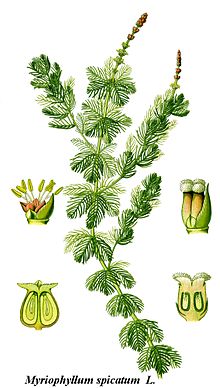Haloragaceae
| Haloragaceae | |
|---|---|

| |
| Myriophyllum spicatum | |
| Scientific classification | |
| Kingdom: | |
| (unranked): | |
| (unranked): | |
| (unranked): | |
| Order: | |
| Family: | Haloragaceae |
| genera | |
|
see text | |
Haloragaceae (the watermilfoil family) is a dicotyledon flowering plant family in the order Saxifragales, based on the phylogenetic APG III system.[1] In the Cronquist system, it was included in the order Haloragales.
Distribution
The distribution of the family is nearly worldwide. The center of species diversity is in Australia where all genera are found excepting Proserpinaca and Laurembergia. The terrestrial taxa are primarily limited to the southern hemisphere. Glishcrocaryon, Haloragodendron, Meionectes and Trihaloragis are Australian endemics.
Description
The family consists mostly of herbaceous perennials or occasionally annuals, although there are some woody taxa (Haloragodendron spp.). Some are primarily terrestrial (Glischrocaryon, Gonocarpus, Haloragis, Haloragodendron and Trihaloragis) while others are primarily semiaquatic (Laurembergia) or aquatic (Meionectes, Myriophyllum and Proserpinaca) of freshwater systems. Myriophyllum are usually monoecious while most other taxa have hermaphrodite flowers. The flowers are usually small and inconspicuous, but some genera can have more "showy" conspicuous flowers (Haloragodendron, Glischrocaryon). Flowers are usually radial (2-3)-4 parted, petals are usually keeled or hooded when present. In Myriophyllum female flowers usually lack a perianth. They have (2-)4-8 stamens and an inferior ovary of (2-)4 carpels. In Myriophyllum the fruit is a schizocarp of 1-seeded 'nutlets' other genera can have nuts or drupes that can be winged or inflated.[2][3]
Floral formula: or
Genera
In the family there are nine genera now recognized, with about 145 species:
- Glischrocaryon
- Gonocarpus
- Haloragis
- Haloragodendron, with five species of bushes, endemic to Australia
- Laurembergia
- Meionectes
- Myriophyllum, with about 69 species of water plants
- Proserpinaca
- Trihaloragis
The taxa of the earlier family Cercodiaceae and Myriophyllaceae are now included in the family Haloragaceae. Earlier, the genus Gunnera was included in this family.
External links
- Taxa of the family in Western Australia
- Article about Haloragodendron lucasii.
- Article about Haloragodendron.
- Haloragaceae of Mongolia in FloraGREIF
References
- ^ a b Angiosperm Phylogeny Group (2009). "An update of the Angiosperm Phylogeny Group classification for the orders and families of flowering plants: APG III" (PDF). Botanical Journal of the Linnean Society. 161 (2): 105–121. doi:10.1111/j.1095-8339.2009.00996.x. Retrieved 2013-07-06.
- ^ Orchard, A.E. (1975). "Taxonomic revisions in the family Haloragaceae. 1. The genera Haloragis, Haloragodendron, Glischrocaryon, Meziella and Gonocarpus ". Bulletin of the Auckland Institute and Museum. 10: 1–299.
- ^ Moody, M.L.; Les, D.H. (2007). "Phylogenetic systematics and character evolution in the angiosperm family Haloragaceae". American Journal of Botany. 94: 2005–2025. doi:10.3732/ajb.94.12.2005. PMID 21636395.


